评估包装正面营养和生态标签对食品评价的多方面影响
IF 4.9
1区 农林科学
Q1 FOOD SCIENCE & TECHNOLOGY
引用次数: 0
摘要
包装正面标签(fopl)是促进健康和可持续食品选择的常用策略。近年来,有越来越多的趋势,不仅强调健康,而且通过不同的fopl可持续性方面,从而导致多重标签。虽然相关,但并发fopl对食品评价的影响尚不清楚。为了阐明这个问题,我们进行了两项具有代表性的在线研究(N = 996和N = 1080),我们要求参与者对15种品牌(研究1)和15种非专利(研究2)零食进行评级,这些零食带有相应的营养和生态标签,包括健康、可持续性、喜欢程度、想要和购买意愿。两项研究均采用2 × 2受试者间设计,有两个因素:营养评分(阳性、阴性)和生态评分(阳性、阴性)。结果表明,当品牌食品和普通食品分别获得积极的营养和生态评分时,它们都获得了更高的健康和可持续性评级。有趣的是,nutrition - score也影响了可持续性评级,支持它的影响可能会推广到其他评级。有两个负面标签的品牌食品明显比有两个正面标签的品牌食品更受欢迎(研究1),然而,当使用普通食品时,这些影响并没有被复制(研究2)。这些发现表明,尽管标签对健康和可持续性的影响似乎是一致的,但它们对喜欢、想要和购买意愿的影响是有限的,可能受到其他因素的调节。未来的研究应该调查在存在多个标签的情况下,标签诱导的食品评价转变如何转化为食品选择。本文章由计算机程序翻译,如有差异,请以英文原文为准。
Evaluating the multi-faceted effect of concurrent front-of-pack nutrition and ecolabels on food evaluation
Front-of-pack labels (FOPLs) are a common strategy employed to promote healthy and sustainable food choices. In the recent years, there has been an increased tendency to highlight not only healthiness but also sustainability aspects via different FOPLs, thereby resulting in multiple labelling. Although relevant, the effects of concurrent FOPLs on food evaluation are yet unclear. To shed light on this question, we conducted two representative studies online (N = 996 and N = 1080) where we asked participants to rate 15 branded (Study 1) and 15 generic (Study 2) snack foods presented with corresponding nutrition and ecolabels in terms of perceived healthiness, sustainability, liking, wanting, and willingness to purchase. Both studies employed a 2 × 2 between-subject design with two factors: Nutri-Score (positive, negative) and Eco-Score (positive, negative). Results indicated that both branded and generic foods received higher healthiness and sustainability ratings when presented with positive Nutri- and Eco-Scores, respectively. Interestingly, Nutri-Score affected sustainability ratings as well, supporting that its effects may generalize to other ratings. Branded food items with two negative labels were liked significantly more than branded food items with two positive labels (Study 1), however these effects were not replicated when using generic food items (Study 2). These findings suggest that while label effects on healthiness and sustainability appear consistent, their effects on liking, wanting, and willingness to purchase are limited and likely modulated by other factors. Future research should investigate how label-induced shifts in food evaluations translate to food choices in the presence of multiple labels.
求助全文
通过发布文献求助,成功后即可免费获取论文全文。
去求助
来源期刊

Food Quality and Preference
工程技术-食品科技
CiteScore
10.40
自引率
15.10%
发文量
263
审稿时长
38 days
期刊介绍:
Food Quality and Preference is a journal devoted to sensory, consumer and behavioural research in food and non-food products. It publishes original research, critical reviews, and short communications in sensory and consumer science, and sensometrics. In addition, the journal publishes special invited issues on important timely topics and from relevant conferences. These are aimed at bridging the gap between research and application, bringing together authors and readers in consumer and market research, sensory science, sensometrics and sensory evaluation, nutrition and food choice, as well as food research, product development and sensory quality assurance. Submissions to Food Quality and Preference are limited to papers that include some form of human measurement; papers that are limited to physical/chemical measures or the routine application of sensory, consumer or econometric analysis will not be considered unless they specifically make a novel scientific contribution in line with the journal''s coverage as outlined below.
 求助内容:
求助内容: 应助结果提醒方式:
应助结果提醒方式:


